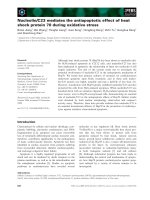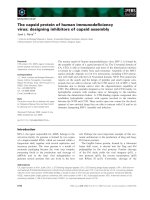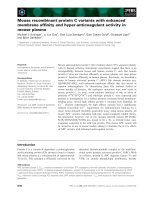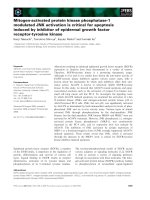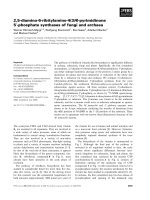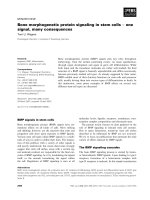Báo cáo khoa học: "Growth arrest-specific protein 6 plasma concentrations during septic shock" potx
Bạn đang xem bản rút gọn của tài liệu. Xem và tải ngay bản đầy đủ của tài liệu tại đây (224.8 KB, 5 trang )
Open Access
Available online />Page 1 of 5
(page number not for citation purposes)
Vol 11 No 1
Research
Growth arrest-specific protein 6 plasma concentrations during
septic shock
Sébastien Gibot
1,2
, Frédéric Massin
3
, Aurélie Cravoisy
1
, Rachel Dupays
1
, Damien Barraud
1
,
Lionel Nace
1
and Pierre-Edouard Bollaert
1
1
Service de Réanimation Médicale, Avenue du Maréchal de Lattre de Tassigny, Hôpital Central, Nancy, 54000, France
2
Projet Avenir INSERM, Coordination Circulation
3
Laboratoire d'Immunologie, Avenue de la Foret de Haye, Faculté de Médecine, Nancy, 54000, France
Corresponding author: Sébastien Gibot,
Received: 13 Nov 2006 Revisions requested: 18 Dec 2006 Revisions received: 1 Jan 2007 Accepted: 22 Jan 2007 Published: 22 Jan 2007
Critical Care 2007, 11:R8 (doi:10.1186/cc5158)
This article is online at: />© 2007 Gibot et al.; licensee BioMed Central Ltd.
This is an open access article distributed under the terms of the Creative Commons Attribution License ( />),
which permits unrestricted use, distribution, and reproduction in any medium, provided the original work is properly cited.
Abstract
Introduction The product of growth arrest-specific gene 6
(Gas6) is a vitamin K dependent protein that is secreted by
leucocytes and endothelial cells in response to injury and
participates in cell survival, proliferation, migration and adhesion.
Our purpose was to investigate plasma Gas6 concentration and
its relation to organ dysfunction in patients with septic shock.
Methods Forty-five patients with septic shock admitted to a
medical adult intensive care unit were enrolled. Plasma Gas6
concentration was determined using enzyme-linked
immunosorbent assay at days 1, 3, 7 and 14.
Results The median (interquartile range) Gas6 concentration
was 51 (5 to 95) pg/ml at admission. A positive correlation
(Spearman rank-order coefficient [rs] = 0.37, P = 0.01) was
found between Gas6 level and Sepsis-related Organ Failure
Assessment score. Patients requiring renal support had higher
Gas6 concentration that those without need for haemofiltration
(76.5 [52 to 164] pg/ml versus 10.5 [1.5 to 80.5] pg/ml; P =
0.04). Moreover, there was a positive correlation between Gas6
and aspartate transaminase (rs = 0.42, P = 0.006) and between
Gas6 and prothrombin time (rs = 0.45, P = 0.02). Although
there was a progressive decline in Gas6 concentration in
survivors (analysis of variance, P = 0.01), nonsurvivors exhibited
persistently elevated Gas6. However, the two populations
diverged only after day 7 (P = 0.04).
Conclusion Plasma concentrations of Gas6 correlate with
disease severity, especially with renal and hepatic dysfunction,
in septic shock.
Introduction
As new therapeutic options emerge for the management of
septic shock, accurate prognostic factors are needed to better
identify those patients who are likely to benefit. Although a
number of severity scores (including Acute Physiology and
Chronic Health Evaluation II score and Simplified Acute Phys-
iology Score [SAPS]II or SAPSIII) and biological markers (pro-
calcitonin [PCT] and C-reactive protein, among others) are
available to predict outcome in critically ill patients, the appro-
priateness of their use during septic shock remains debatable.
The product of growth arrest-specific gene 6 (Gas6) recently
attracted attention because it was found to be elevated during
sepsis and may correlate with organ dysfunction [1]. This vita-
min K dependent protein is secreted by leucocytes and
endothelial cells in response to serum starvation or injury, and
is the biological ligand for the Axl subfamily of receptor tyro-
sine kinases comprising Axl, Sky and Mer [2]. The Gas6/Axl
system participates in cell survival [3,4], proliferation [5],
migration [6] and adhesion [7]. Gas6 is also thought to act as
a recognition bridge between apoptotic cells and phagocytes
that ingest them [8].
Evidence of a role for the Gas6/Axl system during sepsis has
been obtained in mice. Camenisch and coworkers [9]
observed that mice that lack the intracellular domain of c-mer
exhibited increased lipopolysaccharide (LPS)-induced tumor
necrosis factor-α production and suffered increased mortality
Gas6 = growth arrest-specific gene 6 product; LPS = lipopolysaccharide; PCT = procalcitonin; rs = Spearman rank-order coefficient; SOFA = Sep-
sis-related Organ Failure Assessment; sTREM = soluble triggering receptor expressed on myeloid cells.
Critical Care Vol 11 No 1 Gibot et al.
Page 2 of 5
(page number not for citation purposes)
after LPS administration in vivo. Moreover, the same group
demonstrated that mice deficient in c-mer had impaired clear-
ance of apoptotic cells [10].
These data prompted us to investigate plasma concentrations
of Gas6 during septic shock and its relationship with severity
and outcome.
Materials and methods
Study population
Between August 2005 and February 2006, all consecutive
patients admitted with septic shock into a 16-bed medical
intensive care unit of a teaching hospital were enrolled. The
diagnosis of septic shock was established on the basis of cur-
rent definitions [11]. Patients were not enrolled if they were
older than 80 years or were immunocompromised (treatment
with corticosteroids > 1 mg/kg prednisone or equivalent, bone
marrow or organ transplant recipients, neutropenia < 0.5 10
9
/
l, haematologic malignancy, or AIDS). The institutional review
board granted approval, and informed consent was obtained
from patients or their relatives before their inclusion.
Data collection
Upon admission to the intensive care unit, the following items
were recorded: age, sex, severity of underlying medical condi-
tion stratified according to the criteria of McCabe and Jack-
son, SAPSII, Sepsis-related Organ Failure Assessment
(SOFA) score, vital signs, respiratory variables, routine blood
tests and microbial culture results. Outcome was assessed
over a 28-day follow-up period.
Measurement of sTREM-1 and Gas6 plasma
concentrations
Day 1 was defined as the day of admission to the intensive
care unit. Within 12 hours after admission and enrolment in the
study, 5 ml whole heparinized blood was drawn via an arterial
catheter for determination of soluble triggering receptor
expressed on myeloid cells-(sTREM)-1 and Gas6 determina-
tions. Assessment of plasma sTREM-1 levels was performed
as described elsewhere [12]. For Gas6 determination, micro-
titre plates were coated overnight at room temperature with 4
μg/ml of polyclonal mouse anti-human Gas6 antibody (RnD
Systems, Lille, France). After three washes with 0.05% Tween
20 in phosphate-buffered saline, wells were blocked with 1%
bovine serum albumin in phosphate-buffered saline for one
hour at room temperature. Three additional washes were then
performed and 100 μl plasma or standards (recombinant
human Gas6; RnD Systems) were added for two hours at
room temperature. Washes were repeated and 100 ng/ml
biotinylated monoclonal goat anti-human Gas6 antibody (RnD
Systems) added for two hours at room temperature. Detection
was performed with peroxydase-conjugated streptavidin.
Measurements were repeated three times, and intra-assay and
inter-assay coefficients of variation were 6.3% and 7.8%,
respectively.
Repeated determinations of sTREM-1 and Gas6 plasma con-
centrations were performed on days 1, 3, 7 and 14.
Statistical analysis
Descriptive results of continuous variables are expressed as
mean ± standard deviation. Non-normally distributed values,
as assessed using the Kolmogorov-Smirnov test, are reported
as median (interquartile range). Correlations between Gas6
plasma concentration and clinical or biological parameters
were investigated using the Spearman test. Gas6 was also
tested for its association with several variables using the
Mann-Whitney U test. The time course of Gas6 plasma level
was assessed using analysis of variance. Analyses were com-
pleted using Statview software (Abacus Concepts, Berkeley,
CA, USA), and two-tailed P < 0.05 was deemed statistically
significant.
Results
Characteristics of the studied population
Forty-five septic shock patients were included. They were seri-
ously ill, as indicated by need for mechanical ventilation and
vasopressors in all. The main clinical and biological
characteristics are summarized in Table 1. Infection originated
from the lung (community-acquired pneumonia; 62%), the uri-
nary tract (pyolonephritis; 15%), the abdomen (peritonitis;
11%), the heart (endocarditis; 4%) or the skin (necrotizing fas-
ciitis; 4%). The aetiology remained unknown in two patients.
Microbiological documentation was obtained in 31 (68.9%)
patients (Table 2). The high 28-day mortality rate (46.6%) was
to be expected, based on the elevated SAPSII and SOFA
scores.
Baseline plasma concentration of Gas6
Median (interquartile range) Gas6 concentration was 51 (5 to
95) pg/ml at admission. Although Gas6 level did not differ
between survivors and nonsurvivors, a positive correlation
(Spearman rank-order coefficient [rs] = 0.37, P = 0.01) was
observed with SOFA score (Figure 1). However, none of the
components of the SOFA score taken individually (arterial oxy-
gen tension/fractional inspired oxygen, platelet count, bilirubi-
naemia, mean arterial pressure, creatininaemia and Glasgow
Coma Scale score) correlated with Gas6 concentration.
Within the first 24 hours after admission, 12 patients required
renal support (continuous venovenous haemofiltration)
because of acute renal failure. We observed higher Gas6 con-
centrations among these patients than in those without need
for renal support (76.5 [52 to 164] pg/ml versus 10.5 [1.5 to
80.5] pg/ml; P = 0.04; Figure 2). Gas6 was also related to
hepatic function; there were positive correlations between
Gas6 and aspartate transaminase (rs = 0.42, P = 0.006) and
between Gas6 and prothrombin time PT (rs = 0.45, P = 0.02).
Finally, Gas6 was strongly correlated with plasma concentra-
tions of PCT (rs = 0.44, P = 0.005) and sTREM-1 (rs = 0.45,
P = 0.003). No relation between Gas6 and other clinical or
biological features (age, sex, source of infection, infecting
Available online />Page 3 of 5
(page number not for citation purposes)
micro-organism, lactate, leucocyte count, and so on) was
observed.
Time course of Gas6 plasma concentration
Although there was a progressive decline in Gas6 concentra-
tion in the survivors (analysis of variance, P = 0.01), nonsurvi-
vors exhibited persistently elevated Gas6 level (Figure 3).
However, the two populations diverged only after day 7 (P =
0.04), and neither the day 7 Gas6 concentration nor the differ-
ence between days 7 and 1 were sufficiently accurate to pre-
dict final outcome (area under the receiver operating
characteristic curves: 0.58 [0.48 to 0.68] and 0.62 [0.50 to
0.74], respectively; P > 0.05).
Discussion
The main finding of this study is that Gas6 plasma concentra-
tion correlates with organ dysfunction, especially that of kidney
and liver, and several markers of infection during septic shock.
The product of growth arrest-specific gene 6, Gas6, is the bio-
logical ligand for the receptor tyrosine kinase Axl and is impli-
cated in cell survival, proliferation, migration, adhesion and
recognition of dying cells [3-8]. Moreover, the Axl system has
been shown to be essential for functional maturation of natural
killer cells and normal expression of inhibitory and activating
natural killer cell receptors [13]. On one hand, Gas6 thus
appears to be of crucial importance in maintaining cell func-
tion. Evidence to support this view comes from an experimen-
tal model of endotoxaemia [9], in which mice lacking the
intracellular domain of c-mer exhibited increased LPS-induced
tumour necrosis factor-α production and suffered increased
mortality after LPS administration in vivo. However, in support
of findings recently reported by Borgel and coworkers [1], we
observed a good correlation between Gas6 concentration and
organ dysfunction during septic shock. How can these find-
ings be reconciled?
First, because Gas6, via Akt, causes an increase in the antia-
poptotic protein Bcl-2 [14], it is tempting to link the delayed
neutrophil apoptosis observed during sepsis [15] with the
concentration of this protein. An extended neutrophil life time
could therefore contribute to organ injury. Although Gas6 has
clearly been shown to delay cell death both in vitro and in vivo,
this explanation remains hypothetical because we did not spe-
cifically investigate apoptosis.
Second, a deleterious role for Gas6 has been established in
kidney and hepatic disease. Increased glomerular expression
of Gas6 has been detected in animal models of kidney disease
[16], and Gas6 knockout mice were shown to be resistant to
accelerated nephrotoxic nephritis [17]. Gas6 upregulation
was also observed during allograft rejection in a rat kidney
transplant rejection model [18] as well as in dysfunctional
human renal allografts [19]. The link between Gas6 and renal
injury is indirectly supported by our finding that patients
requiring renal support exhbiited increased Gas6 plasma con-
Table 1
Characteristics of patients at inclusion
Characteristic/parameter Patients with septic shock
(n = 45)
Male (n [%]) 31 (69)
Age (years; mean ± SD) 62.3 ± 17.7
SAPSII score (mean ± SD) 64.4 ± 19.3
SOFA score (median [IQR]) 12.5 (11.5–15)
Vasopressors (n [%]) 45 (100)
Mechanical ventilation (n [%]) 45 (100)
CVVH (n [%]) 12 (26.6)
Corticosteroids (n [%]) 36 (80)
Drotrecogin alfa (activated; n
[%])
7 (15.5)
Pao
2
/Fio
2
(median [IQR]) 150 (100–180)
Lactate (mmol/l; median [IQR]) 2.9 (1.9–4.5)
C-reactive protein (mg/l; median
[IQR])
157 (95–225)
Procalcitonin (ng/ml; median
[IQR])
12.6 (3.5–49.6)
sTREM-1 (pg/ml; median [IQR]) 117.5 (37–219.5)
Gas6 (pg/ml; median [IQR]) 51 (5–95)
Mortality rate (n [%]) 21 (46.6)
CVVH, continuous venovenous haemofiltration; Fio
2
, fractional
inspired oxygen; Gas6, growth arrest-specific gene 6 product; IQR,
interquartile range; Pao
2
, arterial oxygen tension; SAPS, Simplified
Acute Physiology Score; SD, standard deviation; SOFA, Sepsis-
related Organ Failure Assessment; sTREM, soluble triggering
receptor expressed on myeloid cells.
Table 2
Micro-organisms associated with sepsis
Micro-organisms Patients with
septic shock
(n = 45)
Bacilli
Escherichia coli 11 (24.4)
Haemophilus spp. 1 (2.2)
Pseudomonas aeruginosa 1 (2.2)
Stenotrophomonas maltophilia 1 (2.2)
Cocci
Streptococcus spp. 13 (28.8)
MSSA 3 (6.6)
Enterococcus spp. 1 (2.2)
Unknown 14 (31.1)
Values are expressed as the number (%) of micro-organisms
isolated. Because of rounding, percentages do not add up to 100.
MSSA, methicilin-sensitive Staphylococcus aureus.
Critical Care Vol 11 No 1 Gibot et al.
Page 4 of 5
(page number not for citation purposes)
centrations compared with those who did not need such sup-
port. Gas6 has also been implicated during hepatic injury [20],
and we observed a correlation between Gas6 concentrations
and hepatic dysfunction. Of course, it is not possible to deter-
mine here whether Gas6 is a bystander during renal and
hepatic injury or directly contributes to dysfunction of these
organs.
The finding that Gas6 strongly correlated with both PCT and
sTREM-1 concentrations is difficult to explain. Gas6 has never
shown to be a marker of infection, and neither PCT nor
sTREM-1 are thought to be reliable severity markers during
septic shock. Does Gas6 stimulate the release of these
proteins? Although Gas6 has been shown in vitro to stimulate
nuclear factor-κB binding activity and subsequent transcrip-
tional activation from nuclear factor-κB responsive promoters
[14,21], this hypothesis remains to be investigated.
Because Gas6 correlated well with organ dysfunction, we
sought to evaluate whether it could be used as a marker of
prognosis. Admission levels of Gas6 did not differ between
survivors and nonsurvivors, and this finding is in accordance
with that reported by Borgel and coworkers [1]. When
patients were segregated according to outcome, we observed
a divergent time course of Gas6 concentrations only at day 7
and after, and therefore Gas6 did not appear to be useful in
predicting outcome during the early period of septic shock.
Nevertheless, because Gas6 concentration was clearly linked
to the degree of organ injury, its use as part of a panel of sever-
ity markers is interesting and could be further tested.
Conclusion
Gas6 plasma concentrations correlate with severity, and espe-
cially renal and hepatic dysfunction, in septic shock. However,
Gas6 by itself is not a reliable early indicator of outcome.
Competing interests
The authors declare that they have no competing interests.
Figure 1
Correlation between plasma Gas6 concentration and SOFA scoreCorrelation between plasma Gas6 concentration and SOFA score. (a)
SOFA scores were separated into quartiles and plotted against Gas6
plasma concentration. Groups were compared using the Mann-Whit-
ney U test. (b) Individual SOFA scores were plotted against Gas6 con-
centration and the correlation was evaluated using the Spearman test
(rs = 0.37, P = 0.01). Gas6, growth arrest-specific gene 6 product;
SOFA, Sepsis-related Organ Failure Assessment.
Figure 2
Plasma Gas6 concentrations according to need for CVVHPlasma Gas6 concentrations according to need for CVVH. The two
groups were compared using the Mann-Whitney U test. CVVH, contin-
uous venovenous haemofiltration; Gas6, growth arrest-specific gene 6
product.
Key messages
• Gas6 plasma concentrations correlate with organ injury
during septic shock, especially hepatic and renal
dysfunction.
• Neither admission level nor time course of Gas6 con-
centration are sufficiently discriminative to permit pre-
diction of outcome during the early period of septic
shock.
Available online />Page 5 of 5
(page number not for citation purposes)
Authors' contributions
SG designed the study, enrolled patients, performed measure-
ments and drafted the manuscript. FM performed measure-
ments. AC, RD, DB and LN enrolled patients. PEB designed
the study and drafted the manuscript. All authors approved the
final version of the manuscript.
References
1. Borgel D, Clauser S, Bornstain C, Bièche I, Bissery A, Remones V,
Fagon JY, Aiach M, Diehl JL: Elevated growth-arrest-specific
protein 6 plasma levels in patients with severe sepsis. Crit
Care Med 2006, 34:219-222.
2. Manfioletti G, Brancolini C, Avanzi G, Schneider C: The protein
encoded by a growth arrest-specific gene (gas6) is a new
member of the vitamin K-dependent proteins related to pro-
tein S, a negative coregulator in the blood coagulation
cascade. Mol Cell Biol 1993, 13:4976-4985.
3. Nakano T, Kawamoto K, Higashino K, Arita H: Prevention of
growth arrest-induced cell death of vascular smooth muscle
cells by a product of growth arrest-specific gene, gas6. FEBS
Lett 1996, 387:78-80.
4. Goruppi S, Ruaro E, Varnum B, Schneider C: Requirement of
phosphatidylinositol 3-kinase-dependent pathway and Src for
Gas6-Axl mitogenic and survival activities in NIH 3T3
fibroblasts. Mol Cell Biol 1997, 17:4442-4453.
5. Stenhoff J, Dahlback B, Hafizi S: Vitamin K-dependent Gas6
activates ERK kinase and stimulates growth of cardiac
fibroblasts. Biochem Biophys Res Commun 2004,
319:871-878.
6. Fridell YW, Villa J Jr, Attar EC, Liu ET: GAS6 induces Axl-medi-
ated chemotaxis of vascular smooth muscle cells. J Biol Chem
1998, 273:7123-7126.
7. McCloskey P, Fridell YW, Attar E: GAS6 mediates adhesion of
cells expressing the receptor tyrosine kinase Axl. J Biol Chem
1997, 272:23285-23291.
8. Wu Y, Singh S, Georgescu MM, Birge RB: A role for Mer tyrosine
kinase in alphavbeta5 integrin-mediated phagocytosis of
apoptotic cells. J Cell Sci 2005, 118:539-553.
9. Camenisch TD, Koller BH, Earp HS, Matsushima GK: A novel
tyrosine kinase, Mer, inhibits TNF-alpha production and
lipopolysaccharide-induced endotoxic shock. J Immunol 1999,
162:3498-3503.
10. Cohen PL, Caricchio R, Abraham V, Camenisch TD, Jennette JC,
Roubey RA, Earp HS, Matsushima G, Reap EA: Delayed apop-
totic cell clearance and lupus-like autoimmunity in mice lack-
ing the c-mer membrane tyrosine kinase. J Exp Med 2002,
196:135-140.
11. Levy MM, Fink MP, Marshall JC, Abraham E, Angus D, Cook D,
Cohen J, Opal SM, Vincent JL, Ramsay G, SCCM/ESICM/ACCP/
ATS/SIS: 2001 SCCM/ESICM/ACCP/ATS/SIS International
Sepsis Definitions Conference. Crit Care Med 2003,
31:1250-1256.
12. Determann R, Millo JL, Gibot S, Korevaar JC, Vroom MB, van der
Poll T, Garrard CS, Schultz MJ: Serial changes in soluble trig-
gering receptor expressed on myeloid cells in the lung during
development of ventilator-associated pneumonia. Intensive
care Med 2005, 31:1495-1500.
13. Caraux A, Lu Q, Fernandez N, Riou S, DiSanto JP, Raulet DH,
Lemke G, Roth C: Natural killer cell differentiation driven by
Tyro3 receptor tyrosine kinases. Nat Immunol 2006,
7:747-754.
14. Hasanbasic I, Cuerquis J, Varnum B, Blostein MD: Intracellular
signalling pathways involved in Gas6-Axl-mediated survival of
endothelial cells. Am J Physiol Heart Circ Physiol 2004,
287:H1207-H1213.
15. Oberholzer C, Oberholzer A, Clare-Salzler R, Moldawer LL: Apop-
tosis in sepsis: a new target for therapeutic exploration.
FASEB J 2001, 15:879-892.
16. Nagai K, Arai H, Yanagita M, Matsubara T, Kanamori H, Nakano T,
Iehara N, Fukatsu A, Kita T, Doi T: Growth arrest-specific gene 6
is involved in glomerular hypertrophy in the early stage of dia-
betic nephropathy. J Biol Chem 2003, 278:18229-18234.
17. Yanagita M, Ishimoto Y, Arai H, Nagai K, Ito T, Nakano T, Salant DJ,
Fukatsu A, Doi T, Kita T: Essential role of Gas6 for glomerular
injury in nephrotoxic nephritis. J Clin Invest 2002,
110:239-246.
18. Yin JL, Pilmore HL, Yan YQ, McCaughan GW, Bishop GA, Hambly
BD, Eris JM: Expression of growth arrest-specific gene 6 and
its receptors in a rat model of chronic renal transplant
rejection. Transplantation 2002, 73:657-660.
19. Yin JL, Hambly BD, Bao SS, Painter D, Bishop GA, Eris JM:
Expression of growth arrest-specific gene 6 and its receptors
in dysfunctional human renal allografts. Transpl Int 2003,
16:681-688.
20. Ladfil F, Chobert MN, Couchie D, Brouillet A, Zafrani ES, Mavier P,
Laperche Y: Induction of Gas6 protein in CCl4-induced rat liver
injury and anti-apoptotic effect on hepatic stellate cells. Hepa-
tology 2006, 44:
228-239.
21. Demarchi F, Verardo R, Varnum B, Brancolini C, Schneider C:
Gas6 anti-apoptotic signalling requires NF-κB activation. J
Biol Chem 2001, 276:31738-31744.
Figure 3
Time course of plasma Gas6 in surviving versus nonsurviving patientsTime course of plasma Gas6 in surviving versus nonsurviving patients. Values are expressed as median with interquartile range. Gas6, growth arrest-
specific gene 6 product.


